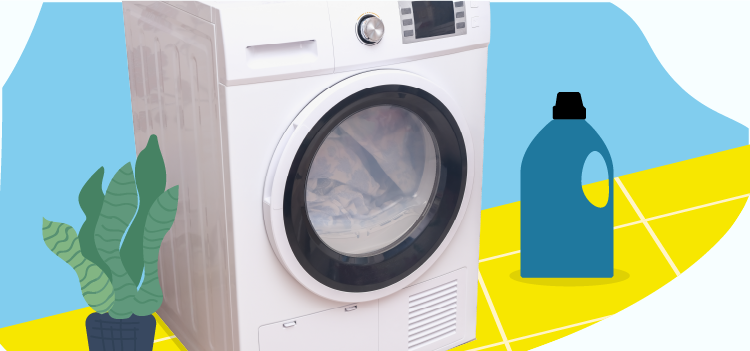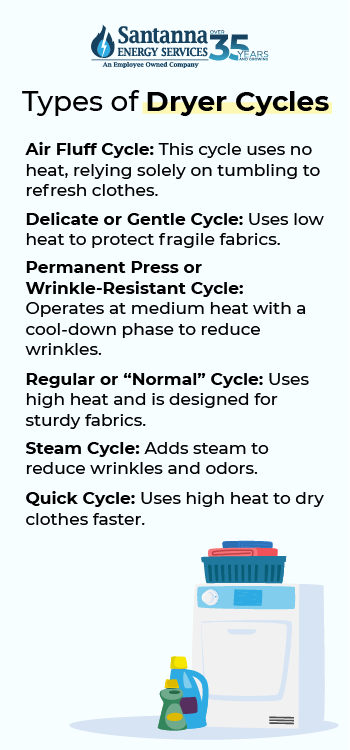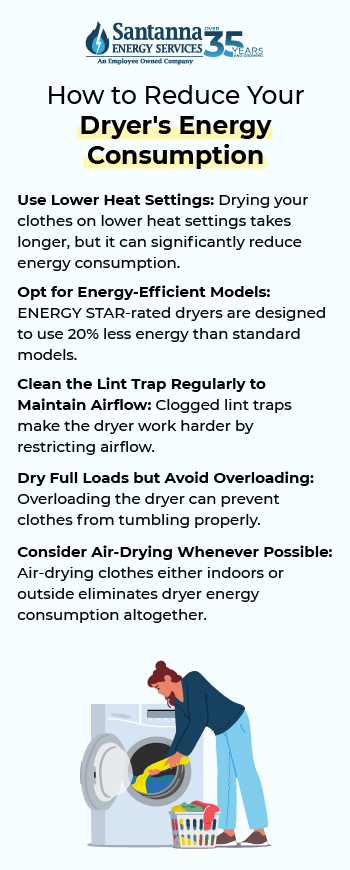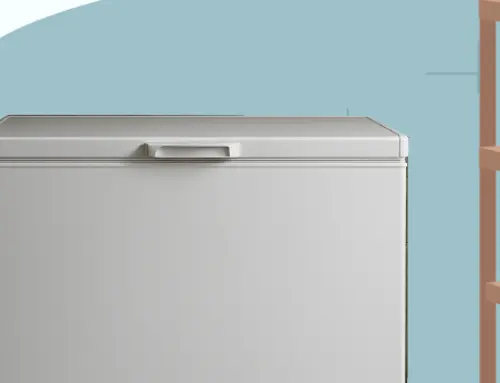How Much Energy Does My Dryer Use Per Hour?
by Tyler Castle
12.8 min read

Dryers are among the highest energy-consuming appliances in homes. With the rising cost of energy, many homeowners are looking to better understand their appliances’ energy consumption to cut down on expenses and make eco-friendly choices. Understanding how much energy they use can help homeowners save on electricity bills and reduce environmental impact.
We’ll break down how much energy a dryer uses per hour, month, year, and even by state. We’ll also cover how your dryer cycle affects your energy consumption and share our tips on how to reduce energy in your laundry routine one pair of pants at a time. Let’s jump in!
How much energy does my dryer use per hour?
We’ve calculated that most electric dryers use between 1.8 to 5 kWh of energy per hour. This is of course, depending on the model and settings. For our calculation, we’re assuming you’re drying your clothes on a “normal” dryer cycle for 27 minutes with a 4,000-watt dryer.
How to calculate how much energy your dryer uses per hour
Determining how much energy your dryer uses per hour is easy with a little simple math. As long as you know the wattage of your dryer and that a kilowatt-hour is equal to one kilowatt of power used for one hour, you can quickly estimate your dryer’s energy consumption.
Here’s how you can calculate how much energy your dryer uses per hour:
- First, you need to find your dryer’s wattage. This is usually on the energy guide sticker on your appliance or you can look up your appliance online to determine your wattage. For our example, let’s assume your appliance uses 3,000 watts of energy.
- Next, convert watts into kilowatts by dividing by 1,000 (the amount of watts in one kilowatt). For our example, this would shake out to 3 kW.
- In the next step, multiply the kW (3) by the hours of use per cycle. For a 27-minute cycle, this would equal roughly 0.45 hours. Then calculate your energy use by multiplying your kW by your hours per cycle to determine how much energy your dryer uses per hour: 3kW X 0.45 = 1.35 kWh.
So, for a 3,000-watt dryer on a 27-minute cycle, your dryer would use 1.35 kWh of energy per hour.
How to calculate the cost to run your dryer per hour
Calculating your clothes dryer power usage is easy as long as you know your energy rate. Using 1.35 kWh we calculated from our example above, simply multiply this by your monthly electricity rate.
For our example, we’ll use the U.S. average residential electricity rate calculated from the E.I.A*. of 16.63 cents per kilowatt-hour.
Using this formula – Power consumption (kWh) × Electricity rate ($/kWh) = Total cost for the cycle – at 1.35 kWh and your electricity rate is $0.1663/kWh, the cost to run your dryer for one hour would be $0.22 per hour. Keep in mind that your electricity rate does change depending on your location so your cost will vary.
Clothes dryer power usage: hourly costs to run a clothes dryer by state
If you’re curious about how much your clothes dryer’s power usage will cost you in a specific state, we can help.
Let’s say you have an electric dryer on a “normal” cycle (for 27 minutes) that uses an average of 1.8 kWh per hour. Here’s how much it will cost you to run your dryer per hour at the average electricity rates calculated by the E.I.A by state*:
Clothes Dryer Power Usage By State
| State | Average Energy Usage (per hour) | Average Electricity Rate According to the E.I.A*
(Cents per Kilowatt-hour) |
Cost Per Hour |
|---|---|---|---|
| Ohio | 1.8 kWh | $0.1612 | $0.29 |
| Pennsylvania | 1.8 kWh | $0.1843 | $0.33 |
| Illinois | 1.8 kWh | $0.1759 | $0.32 |
| Michigan | 1.8 kWh | $0.1937 | $0.35 |
| Indiana | 1.8 kWh | $0.1487 | $0.27 |
Factors that influence how much energy your dryer uses per hour and over time
Like any appliance, there are things within and out of your control that can affect your clothes dryer power usage throughout its lifetime. Here are some of the most common factors:
Load Size: Larger loads use more energy as the dryer works longer to dry more clothes. However, drying smaller loads more frequently can be inefficient too.
Heat Settings: Dryers come with various heat settings, like low, medium, and high. Higher heat settings dry clothes faster but use more energy. Using medium or low heat settings can reduce energy consumption, though the drying time may be slightly longer.
Dryer Age and Condition: Older dryers tend to be less energy-efficient compared to newer models, particularly ENERGY STAR-rated ones. The older your dryer gets, the more it affects your clothes dryer power usage; the harder your model has to work overtime, results in more energy being used.
Lint Trap Cleanliness: A clogged lint trap forces the dryer to work harder to push air through, which increases drying time and energy use. Regularly cleaning the lint trap improves air circulation, reduces energy consumption, and can reduce your risk of fires too.
Moisture Sensor Technology: Many modern dryers come with moisture sensors that stop the machine when clothes are dry, rather than running for a preset time. These sensors prevent over-drying, saving energy by reducing the machine's run time.
Ventilation Efficiency: Properly installed and maintained dryer vents help exhaust air efficiently. Blocked or inefficient vents reduce airflow, affects how much energy your dryer uses per hour and leads to increased energy consumption.
Average energy usage for different types of clothes dryers
When considering different types of clothes dryers, their energy consumption varies depending on the model and design. Electric dryers generally, consume between 1.8 to 5 kWh per hour, making them the most common choice but also one of the higher energy users. Electric dryers can increase your energy costs simply because they use high levels of electricity to generate the heat needed for drying clothes.
Gas dryers, on the other hand, are more energy-efficient, using just 0.7 kWh per hour, although they also rely on natural gas, which can impact overall energy costs.
Front-load dryers and top-load dryers have similar energy usage, both typically ranging from 1.8 to 5 kWh per hour. However, front-load dryers are often considered more energy-efficient due to better moisture extraction during the spin cycle, which can shorten drying times. Vented dryers are another common type, using between 2.4 to 4.8 kWh per hour.
Overall, the type of dryer you choose to use can impact how much energy your dryer uses per hour and over time.
How does your cycle choice affect your clothes dryer power usage?
The type of dryer cycle you use can greatly affect your dryer's energy consumption. Different dryer settings use varying heat levels and drying times depending on the type of clothing you're looking to dry. Most clothes dryers come with 5-10 dryer settings with time variations that can affect how much energy a dryer uses per hour and per cycle.
Cycle types and their efficiency
There are six types of dryer cycles that are most commonly used in homes. Let's look at their cycle times, what type of clothing they are ideal for, and how they affect your clothes dryer power usage:
Air Fluff Cycle: This cycle uses no heat, relying solely on tumbling to refresh clothes or remove dust. It's the most energy-efficient option since it consumes only the energy needed to spin the drum, but it's not suitable for drying wet clothes.
Delicate or Gentle Cycle: Uses low heat to protect fragile fabrics like silk or lace. While it consumes less energy per minute compared to higher heat settings, the longer drying time may increase total energy consumption. It's still more efficient for items that don't require high heat.
Permanent Press or Wrinkle-Resistant Cycle: Operates at medium heat with a cool-down phase to reduce wrinkles. It balances energy efficiency and garment care, using less energy than high-heat cycles but more than delicate or air-fluff options.
Regular or "Normal" Cycle: Uses high heat and is designed for sturdy fabrics like cotton. It dries clothes faster, which can save energy for a single load. However, if used for more delicate items, it can waste energy and potentially damage clothes.
Steam Cycle: Adds steam to reduce wrinkles and odors. This feature consumes more energy than traditional drying since it requires additional heat to produce steam, making it less energy-efficient.
Quick Cycle: Uses high heat to dry clothes faster, making it efficient for small loads in a hurry. However, frequent use of large loads can lead to higher energy consumption overall.

Selecting the appropriate cycle for each load can help optimize energy use while effectively drying your clothes. Here's how much energy a dryer uses per cycle and its costs:
Cost and Power Usage of Common Clothes Dryer Cycles
| Dryer Cycle Type | Dryer Watts | Time cycles for each wash cycle | Energy Consumption of Each Cycle (in kWh) | Cost* (Based on the U.S. Average of $0.1711 per kWh) |
|---|---|---|---|---|
| Air Fluff Cycle | 4,300 watts | 10 minutes | 0.717 kWh | $0.12 |
| Delicate or Gentle Cycle | 4,300 watts | 30 minutes | 2.15 kWh | $0.37 |
| Permanent Press or Wrinkle-Resistant Cycle | 4,300 watts | 32 minutes | 2.29 kWh | $0.39 |
| Regular or “Normal” Cycle | 4,300 watts | 1 hour and 8 minutes | 4.6 kWh | $0.83 |
| Steam Cycle | 4,300 watts | 3 hours | 12.9 kWh | $2.21 |
| Quick Cycle | 4,300 watts | 57 minutes | 4.08 kWh | $0.70 |
For this example, our dryer wattage and cycle times are based off the settings and wattage of the GE 7.8 cu. Ft. Front Load Dryer that uses 4,300 watts.
Using the same machine and assuming you use your dryer 5 times a week, 22 per month, and 260 times per year, here is the annual energy consumption and cost of each cycle:
How Much Energy a Dryer Uses Per Hour, Week, Month and Year by Cycle (Based of 4,300 watts)
| Dryer Cycle Type | Hourly Energy Consumption (kWh) | Weekly Consumption (kWh) | Monthly Consumption (kWh) | Yearly Consumption (kWh) |
|---|---|---|---|---|
| Air Fluff Cycle | 0.717 | 3.59 | 15.77 | 186.42 |
| Delicate or Gentle Cycle | 2.15 | 10.75 | 47.3 | 559 |
| Permanent Press or Wrinkle-Resistant Cycle | 2.29 | 11.45 | 50.38 | 595.4 |
| Regular or “Normal” Cycle | 4.6 | 23.0 | 107.1 | 1253.6 |
| Steam Cycle | 12.9 | 64.5 | 283.8 | 3307 |
| Quick Cycle | 4.08 | 20.4 | 89.8 | 1060.8 |
Using the same machine at 4,300 watts and based on the median electricity rate in the U.S. calculated by the E.I.A* at $0.1711 cents per kilowatt-hour, here’s the average hourly, weekly, monthly, and yearly cost of each dryer cycle.
How Much Does It Cost to Run a Dryer Per Hour, Week, Month and Year by Cycle (Based of 4,300 watts)
| Dryer Cycle Type | Hourly Energy Consumption (kWh) | Weekly Consumption (kWh) | Monthly Consumption (kWh) | Yearly Consumption (kWh) |
|---|---|---|---|---|
| Air Fluff Cycle | $0.12 | $0.60 | $2.57 | $30.39 |
| Delicate or Gentle Cycle | $0.37 | $1.78 | $7.52 | $89.71 |
| Permanent Press or Wrinkle-Resistant Cycle | $0.39 | $1.86 | $7.59 | $89.83 |
| Regular or “Normal” Cycle | $0.83 | $3.91 | $16.83 | $202.43 |
| Steam Cycle | $2.21 | $10.43 | $44.85 | $539.09 |
| Quick Cycle | $0.70 | $3.37 | $14.47 | $173.69 |
This is assuming you use your dryer 5 times a week, 22 per month, and 260 times per year using the same cycle.
How to reduce your dryer’s energy consumption
Dryers are one of the highest energy-consuming appliances in the home, but a few small changes can help you lower their impact on your energy bill. Here are a few of our favorite tips:

- Use Lower Heat Settings: Drying your clothes on lower heat settings takes longer, but it can significantly reduce energy consumption. Lower heat also causes less wear on your clothes, making it a win-win.
- Opt for Energy-Efficient Models (like ENERGY STAR): ENERGY STAR-rated dryers are designed to use 20% less energy than standard models. They include features like moisture sensors that automatically shut off the dryer when clothes are dry, preventing unnecessary energy usage.
- Clean the Lint Trap Regularly to Maintain Airflow: Clean the lint filter after every load. Clogged lint traps make the dryer work harder by restricting airflow, leading to higher energy use and increasing the risk of fire.
- Dry Full Loads but Avoid Overloading: Drying full loads maximizes energy efficiency because the dryer runs less frequently. However, overloading the dryer can prevent clothes from tumbling properly and result in longer drying times.
- Consider Air-Drying Whenever Possible: Air-drying clothes either indoors or outside eliminates dryer energy consumption altogether. For items that take longer to dry in a machine, like towels or sheets, this can be a practical alternative. Plus, who doesn’t love the smell of sun-kissed clothes?
Which dryer is right for your home?
Choosing the right dryer for your home can make a difference in energy costs and drying efficiency. Here are some of your best options
Electric vs. Gas Dryers
Electric Dryers: These are more common and easier to install since they only require a standard electrical outlet. They generally have a lower upfront cost but may be more expensive to run in the long term due to higher electricity rates.
Gas Dryers: More energy-efficient than electric models, gas dryers tend to have lower operational costs, but they require a gas line and professional installation, which can increase initial costs.
Gas dryers are often more energy-efficient over time, as natural gas tends to be cheaper than electricity. However, this varies by region. Electric dryers might have a higher operational cost due to electricity rates, whereas gas dryers can save you money on energy bills, depending on the cost of gas in your area.
Eco-Friendly Dryer Models
Heat Pump Dryers: These dryers use a heat pump to recycle warm air within the dryer, making them far more energy-efficient than conventional electric models. They consume less electricity and are gentler on clothes.
Heat pump dryers are ideal for People looking to lower their energy use and utility bills. However, these models typically come with a higher upfront cost.
FAQs
What size battery do you need to back up a clothes dryer?
For running a dryer, you would ideally need a battery system that can deliver 5 kWh for each hour the dryer operates.
What is the best time of the year to buy a washer and dryer?
The best time to buy a washer and dryer typically happens during holiday sales like Black Friday, Labor Day, and President’s Day which features significant discounts on appliances. In the same way, September and October are also the best time of the year to buy washers and dryers. As stores clear out older inventory can be a good opportunity to buy as well.
How hot does a clothes dryer get?
A clothes dryer can get as hot as 120°F to 160°F for heavy fabrics. Temperature varies by cycle to ensure proper drying without damaging clothes.
How long is a dryer cycle?
The length of a dryer depends on several factors, including the type of dryer, the chosen cycle setting, and the load size. For a standard electric dryer, a “normal” dryer cycle typically lasts between 30 to 45 minutes.
However, specialized settings like “heavy-duty” or “towels” may extend the cycle to 60 minutes or more, while “delicate” or “quick-dry” settings might only take 15 to 25 minutes.
In the end, understanding how much energy your dryer uses per hour and over time can help you evaluate and align your energy goals. Don’t let the thought of your increasing energy bills compromise what’s right for your clothes! With Santanna’s Unlimited Energy Plan, you can enjoy a predictable monthly supply charge every month no matter how many loads of laundry you do!**
At Santanna Energy Services, we’re committed to providing energy solutions that not only meet your energy needs but are also right for your lifestyle. Whether you’re considering an energy plan upgrade or simply want to explore your options, Santanna is here to help guide you towards smarter, more efficient energy practices.
*U.S. electricity rate and average rate by state can be found at this link calculated from the E.I.A. as of August 2024.
**Restrictions apply. Enrollment based upon program eligibility. Customers using more than 125% of normal monthly usage as determined by Santanna may be required to switch plans.
Tyler is an experienced energy professional, having worked for Santanna Energy Services, for the past four years. He is passionate about renewable energy and believes that diversifying the energy grid is the key to a sustainable future. Tyler is dedicated to supplying consumers with the best possible energy solutions and works diligently to make sure that Santanna can deliver the highest quality service.







